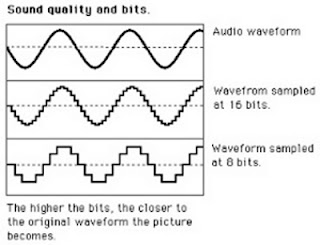We have created a database with information ralated with music. We have also made three queries; you can look for information through the name of the group, the name of the song, or the name of the album.
Click here to see our practice.
Monicandrea
martes, 7 de junio de 2016
DATA BASES
A relational
database is a collection of data items organized in relations
as a set of tables from which data can be accessed or reassembled in
many different ways without having to reorganize the database tables.
Each table is
composed of a set of records and each one is identified by attributes called
fields, which contain a unique value. Because of how fields are organized in a
table users can access the data in almost unlimited number of ways.
Database is
used to store lots of information. It enables a quick and very easy
access to information. It's also very easy to add
new information or delete old one. In addition one person can
access it at the same like, which means it is multi-access.
Specific
information is stored depending on the database's intended use. For example,
the police have details of all known criminals in a database (all the crimes
they've comitted). When trying to solve a crime they use the database to
investigate possible criminals.
Relational database has two specific types of keys:
Relational database has two specific types of keys:
- Primary key: it exists just one particular
record for each field in a table. It can´t be repeated.
- Foreign key:it can relate different types
of records by just one table
miércoles, 11 de mayo de 2016
Digital Sound
DIGITAL SOUND
An audio recording can come in two basic types:
analog or digital. Both of these types are created by turning air pressure (the
sound) into electrical analog signal. In an analog recording the electrical
signals are directly imprinted onto the master tape or master record. These are
original copies of an audio tape that can be used to produce other copies. In
case of the analog recording, copies of the master tape or master record can be
made into cassette tapes or vinyls. In
the other hand digital recording makes a series of number out of the analog
signal, which the softerware of a computer will be able to understand. Once the
signal is digitalized, The recording can be copied ontp a compact disc, a hard
drive etc.
The fidelity of an analog recording depends on
the sensitivity of the equipment and the mediums used to record and play back
the audio.
The digital audio fidelity, however, depends on
the rate at which the recording equipment sampled the original sound wave over
a specific period of time. This last concept is known as sample rate and is
defined as the number of samples of a sound that are taken per second to
represent a sound wave digitally. Another measure of quality of digital adios
is the sample formant which is measured by the number of computer bits used to
represent each sample. The higher the number of bits used, the more accurate
and precise the representation of each sample will be. The number of bits is
also relevant because it, maximizes the difference between the loudest and the
softest possible sounds (dynamic range). Common sample formants are: 8-bit,
16-bit, 24-bit and 32-bit.
Some people claim that analog sound is better
than the digital one because it replicates the sound wave exactly as it was.
Nevertheless some people say that high sampling rates and increased precision have
erased any distinction that may have existed between these two types of sound.
ARKANDID GAME
Click here to Download
int y=300;
int x=300;
int yspeed=8;
int xspeed=-6;
int score=0;
int brokenbrick=0;
int cont =0;
void setup(){
size(600,600);
fill(0,0,0);
background(255.255,255);
}
void draw(){
background(255);
fill(0);
text("yspeed:"+ yspeed,10,10);
text("y:"+ y,10,30);
text("score:"+score,10,50);
text("brokenbrick:"+brokenbrick, 10,70);
text("score:"+score, 10,50);
fill(x,y,250);
ellipse (x,y,40,40);
y=y + yspeed;
x=x + xspeed;
if (y<0 || y>600){
yspeed=yspeed*-1;}
if (x<0 || x>600){
xspeed=xspeed*-1;}
fill(0);
rect(mouseX,550, 90,20);
if (x>mouseX && x<mouseX+90 && y>535){
yspeed=yspeed*-1;
xspeed=(x-(mouseX+45))/10;
}
if(brokenbrick==0){
fill(255,153,255);
rect(100,100,120,30);
}
if (brokenbrick ==1){ cont= cont+1;}
if (x>80 && x<240 && y>80 && y<150){
yspeed=yspeed*-1;
brokenbrick=1;
score=score + 10;}
if (cont==20){
stop();
background(102,255,102);
fill(0,102,0);
textSize(60);
text("CONGRATULATIONS!",10,250);
text("YOU WON:)",120,320);
}
if (y>600){
background(0);
fill(9,255,240);
textSize(60);
text("GAME OVER :(",100,300);
stop();
}
}
int y=300;
int x=300;
int yspeed=8;
int xspeed=-6;
int score=0;
int brokenbrick=0;
int cont =0;
void setup(){
size(600,600);
fill(0,0,0);
background(255.255,255);
}
void draw(){
background(255);
fill(0);
text("yspeed:"+ yspeed,10,10);
text("y:"+ y,10,30);
text("score:"+score,10,50);
text("brokenbrick:"+brokenbrick, 10,70);
text("score:"+score, 10,50);
fill(x,y,250);
ellipse (x,y,40,40);
y=y + yspeed;
x=x + xspeed;
if (y<0 || y>600){
yspeed=yspeed*-1;}
if (x<0 || x>600){
xspeed=xspeed*-1;}
fill(0);
rect(mouseX,550, 90,20);
if (x>mouseX && x<mouseX+90 && y>535){
yspeed=yspeed*-1;
xspeed=(x-(mouseX+45))/10;
}
if(brokenbrick==0){
fill(255,153,255);
rect(100,100,120,30);
}
if (brokenbrick ==1){ cont= cont+1;}
if (x>80 && x<240 && y>80 && y<150){
yspeed=yspeed*-1;
brokenbrick=1;
score=score + 10;}
if (cont==20){
stop();
background(102,255,102);
fill(0,102,0);
textSize(60);
text("CONGRATULATIONS!",10,250);
text("YOU WON:)",120,320);
}
if (y>600){
background(0);
fill(9,255,240);
textSize(60);
text("GAME OVER :(",100,300);
stop();
}
}
miércoles, 16 de marzo de 2016
domingo, 7 de febrero de 2016
IMPOSSIBLE IMAGE
Final impossible image:

Images we have need for the impossible image:

Links to download the images used:
Links to download the final imposible image:
miércoles, 16 de diciembre de 2015
Suscribirse a:
Entradas (Atom)











